Nursing Research Report on Hand Hygiene Compliance and Infections
VerifiedAdded on 2022/08/08
|8
|2166
|61
Report
AI Summary
This nursing research report investigates the critical link between hand hygiene compliance and the prevention of nosocomial infections within healthcare settings. The report begins by outlining the significance of the issue and establishes a PICOT question to guide the research. It then critically analyzes both quantitative and qualitative studies, exploring various methodologies and their respective results. The report examines the ethical considerations of the studies and their implications for nursing practice. The core focus is on evaluating evidence-based practices to improve hand hygiene adherence, thereby reducing hospital-acquired infections. The report proposes specific practice changes, emphasizing training and education to enhance healthcare professionals' compliance with hand hygiene guidelines. The conclusion reiterates the importance of addressing barriers to hand hygiene and highlights the role of evidence-based strategies in improving patient outcomes.
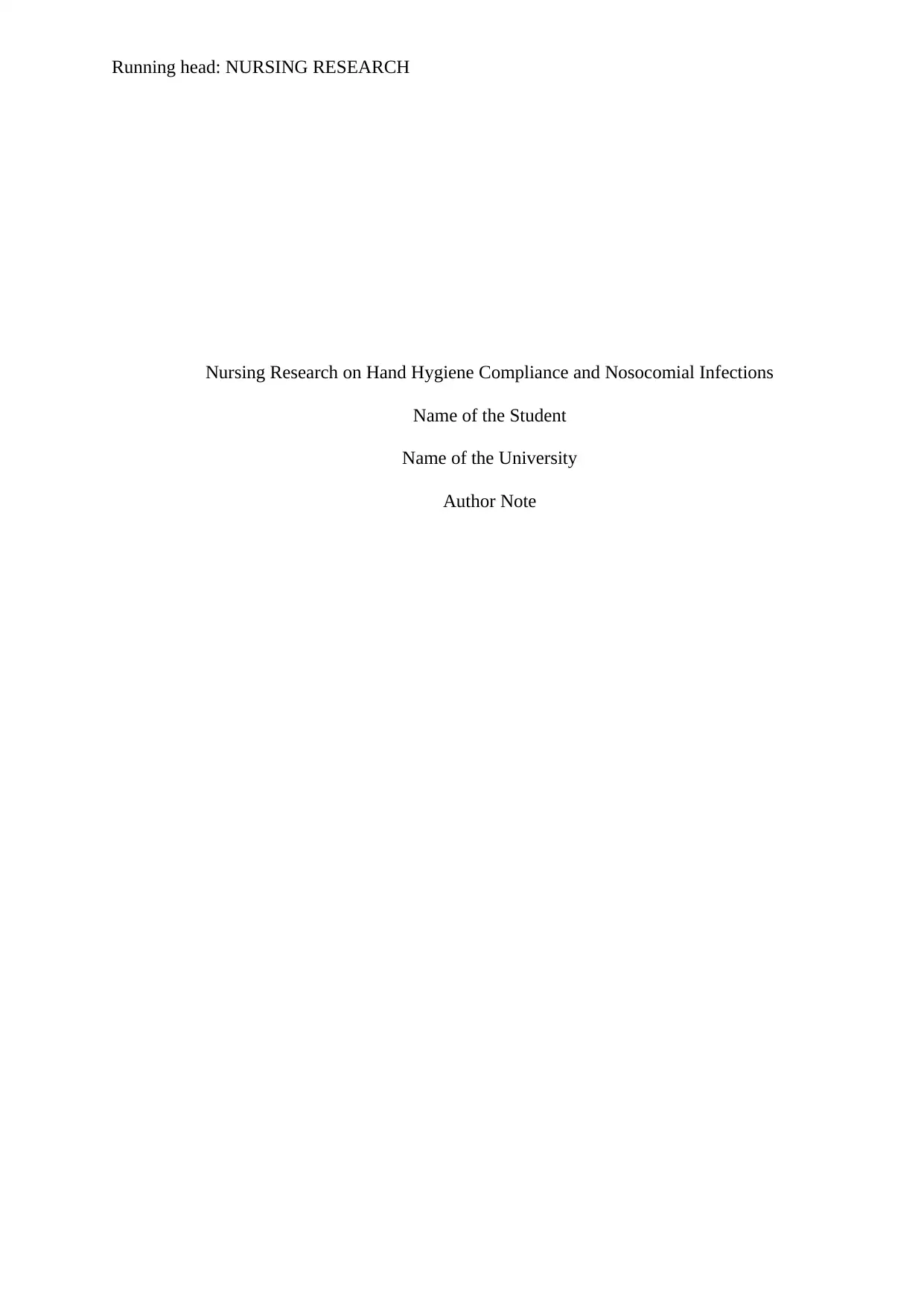
Running head: NURSING RESEARCH
Nursing Research on Hand Hygiene Compliance and Nosocomial Infections
Name of the Student
Name of the University
Author Note
Nursing Research on Hand Hygiene Compliance and Nosocomial Infections
Name of the Student
Name of the University
Author Note
Paraphrase This Document
Need a fresh take? Get an instant paraphrase of this document with our AI Paraphraser
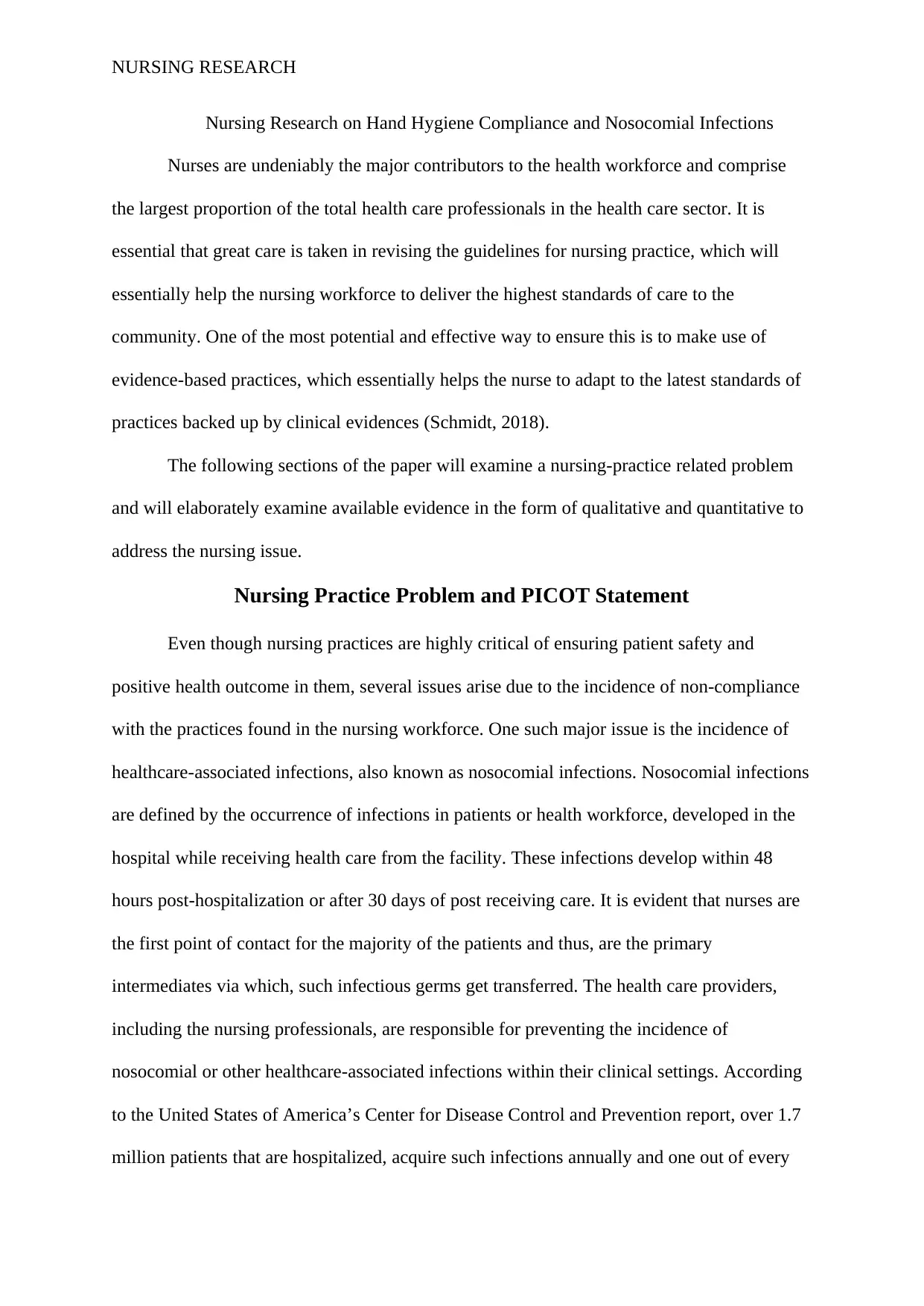
NURSING RESEARCH
Nursing Research on Hand Hygiene Compliance and Nosocomial Infections
Nurses are undeniably the major contributors to the health workforce and comprise
the largest proportion of the total health care professionals in the health care sector. It is
essential that great care is taken in revising the guidelines for nursing practice, which will
essentially help the nursing workforce to deliver the highest standards of care to the
community. One of the most potential and effective way to ensure this is to make use of
evidence-based practices, which essentially helps the nurse to adapt to the latest standards of
practices backed up by clinical evidences (Schmidt, 2018).
The following sections of the paper will examine a nursing-practice related problem
and will elaborately examine available evidence in the form of qualitative and quantitative to
address the nursing issue.
Nursing Practice Problem and PICOT Statement
Even though nursing practices are highly critical of ensuring patient safety and
positive health outcome in them, several issues arise due to the incidence of non-compliance
with the practices found in the nursing workforce. One such major issue is the incidence of
healthcare-associated infections, also known as nosocomial infections. Nosocomial infections
are defined by the occurrence of infections in patients or health workforce, developed in the
hospital while receiving health care from the facility. These infections develop within 48
hours post-hospitalization or after 30 days of post receiving care. It is evident that nurses are
the first point of contact for the majority of the patients and thus, are the primary
intermediates via which, such infectious germs get transferred. The health care providers,
including the nursing professionals, are responsible for preventing the incidence of
nosocomial or other healthcare-associated infections within their clinical settings. According
to the United States of America’s Center for Disease Control and Prevention report, over 1.7
million patients that are hospitalized, acquire such infections annually and one out of every
Nursing Research on Hand Hygiene Compliance and Nosocomial Infections
Nurses are undeniably the major contributors to the health workforce and comprise
the largest proportion of the total health care professionals in the health care sector. It is
essential that great care is taken in revising the guidelines for nursing practice, which will
essentially help the nursing workforce to deliver the highest standards of care to the
community. One of the most potential and effective way to ensure this is to make use of
evidence-based practices, which essentially helps the nurse to adapt to the latest standards of
practices backed up by clinical evidences (Schmidt, 2018).
The following sections of the paper will examine a nursing-practice related problem
and will elaborately examine available evidence in the form of qualitative and quantitative to
address the nursing issue.
Nursing Practice Problem and PICOT Statement
Even though nursing practices are highly critical of ensuring patient safety and
positive health outcome in them, several issues arise due to the incidence of non-compliance
with the practices found in the nursing workforce. One such major issue is the incidence of
healthcare-associated infections, also known as nosocomial infections. Nosocomial infections
are defined by the occurrence of infections in patients or health workforce, developed in the
hospital while receiving health care from the facility. These infections develop within 48
hours post-hospitalization or after 30 days of post receiving care. It is evident that nurses are
the first point of contact for the majority of the patients and thus, are the primary
intermediates via which, such infectious germs get transferred. The health care providers,
including the nursing professionals, are responsible for preventing the incidence of
nosocomial or other healthcare-associated infections within their clinical settings. According
to the United States of America’s Center for Disease Control and Prevention report, over 1.7
million patients that are hospitalized, acquire such infections annually and one out of every
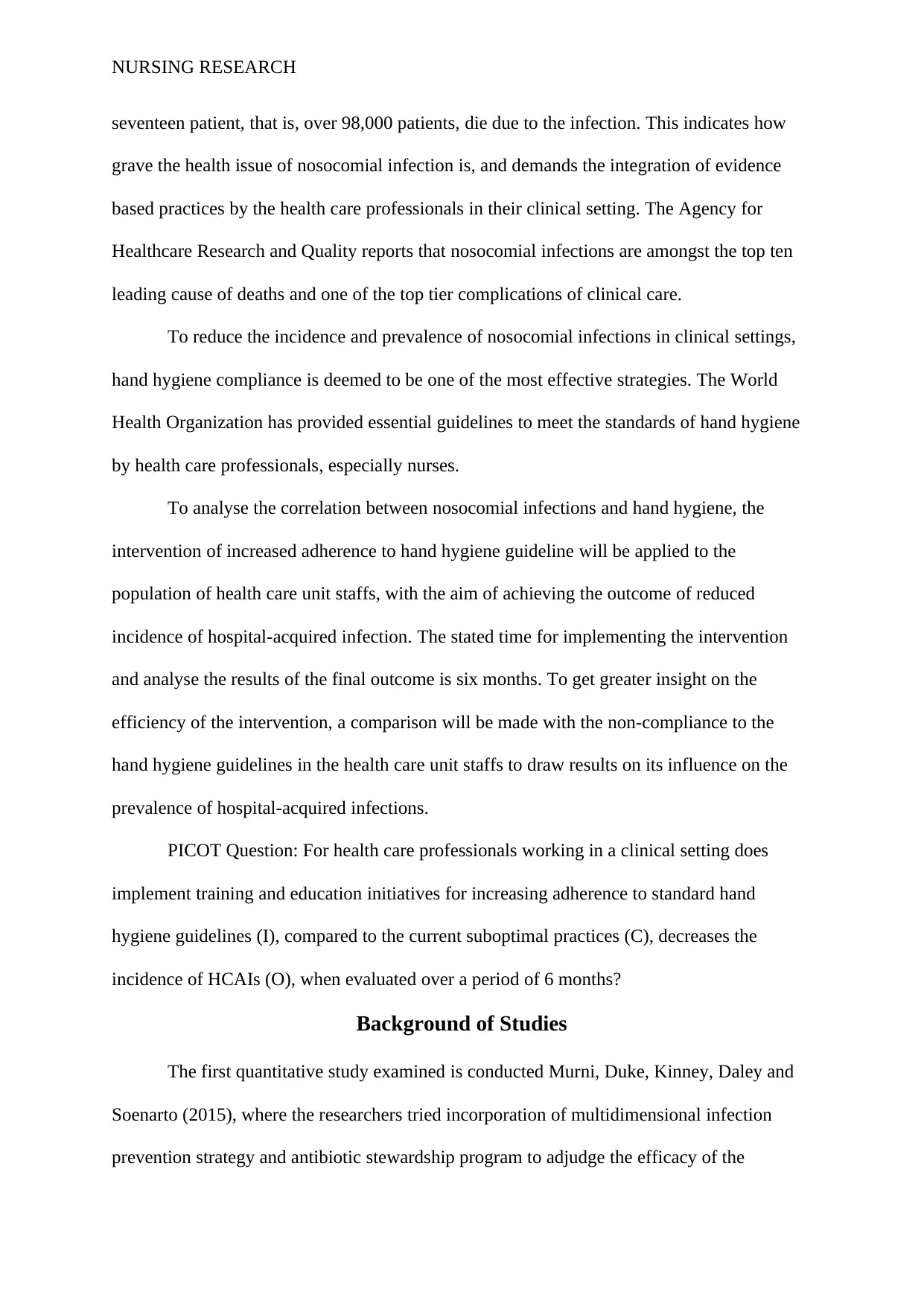
NURSING RESEARCH
seventeen patient, that is, over 98,000 patients, die due to the infection. This indicates how
grave the health issue of nosocomial infection is, and demands the integration of evidence
based practices by the health care professionals in their clinical setting. The Agency for
Healthcare Research and Quality reports that nosocomial infections are amongst the top ten
leading cause of deaths and one of the top tier complications of clinical care.
To reduce the incidence and prevalence of nosocomial infections in clinical settings,
hand hygiene compliance is deemed to be one of the most effective strategies. The World
Health Organization has provided essential guidelines to meet the standards of hand hygiene
by health care professionals, especially nurses.
To analyse the correlation between nosocomial infections and hand hygiene, the
intervention of increased adherence to hand hygiene guideline will be applied to the
population of health care unit staffs, with the aim of achieving the outcome of reduced
incidence of hospital-acquired infection. The stated time for implementing the intervention
and analyse the results of the final outcome is six months. To get greater insight on the
efficiency of the intervention, a comparison will be made with the non-compliance to the
hand hygiene guidelines in the health care unit staffs to draw results on its influence on the
prevalence of hospital-acquired infections.
PICOT Question: For health care professionals working in a clinical setting does
implement training and education initiatives for increasing adherence to standard hand
hygiene guidelines (I), compared to the current suboptimal practices (C), decreases the
incidence of HCAIs (O), when evaluated over a period of 6 months?
Background of Studies
The first quantitative study examined is conducted Murni, Duke, Kinney, Daley and
Soenarto (2015), where the researchers tried incorporation of multidimensional infection
prevention strategy and antibiotic stewardship program to adjudge the efficacy of the
seventeen patient, that is, over 98,000 patients, die due to the infection. This indicates how
grave the health issue of nosocomial infection is, and demands the integration of evidence
based practices by the health care professionals in their clinical setting. The Agency for
Healthcare Research and Quality reports that nosocomial infections are amongst the top ten
leading cause of deaths and one of the top tier complications of clinical care.
To reduce the incidence and prevalence of nosocomial infections in clinical settings,
hand hygiene compliance is deemed to be one of the most effective strategies. The World
Health Organization has provided essential guidelines to meet the standards of hand hygiene
by health care professionals, especially nurses.
To analyse the correlation between nosocomial infections and hand hygiene, the
intervention of increased adherence to hand hygiene guideline will be applied to the
population of health care unit staffs, with the aim of achieving the outcome of reduced
incidence of hospital-acquired infection. The stated time for implementing the intervention
and analyse the results of the final outcome is six months. To get greater insight on the
efficiency of the intervention, a comparison will be made with the non-compliance to the
hand hygiene guidelines in the health care unit staffs to draw results on its influence on the
prevalence of hospital-acquired infections.
PICOT Question: For health care professionals working in a clinical setting does
implement training and education initiatives for increasing adherence to standard hand
hygiene guidelines (I), compared to the current suboptimal practices (C), decreases the
incidence of HCAIs (O), when evaluated over a period of 6 months?
Background of Studies
The first quantitative study examined is conducted Murni, Duke, Kinney, Daley and
Soenarto (2015), where the researchers tried incorporation of multidimensional infection
prevention strategy and antibiotic stewardship program to adjudge the efficacy of the
⊘ This is a preview!⊘
Do you want full access?
Subscribe today to unlock all pages.

Trusted by 1+ million students worldwide
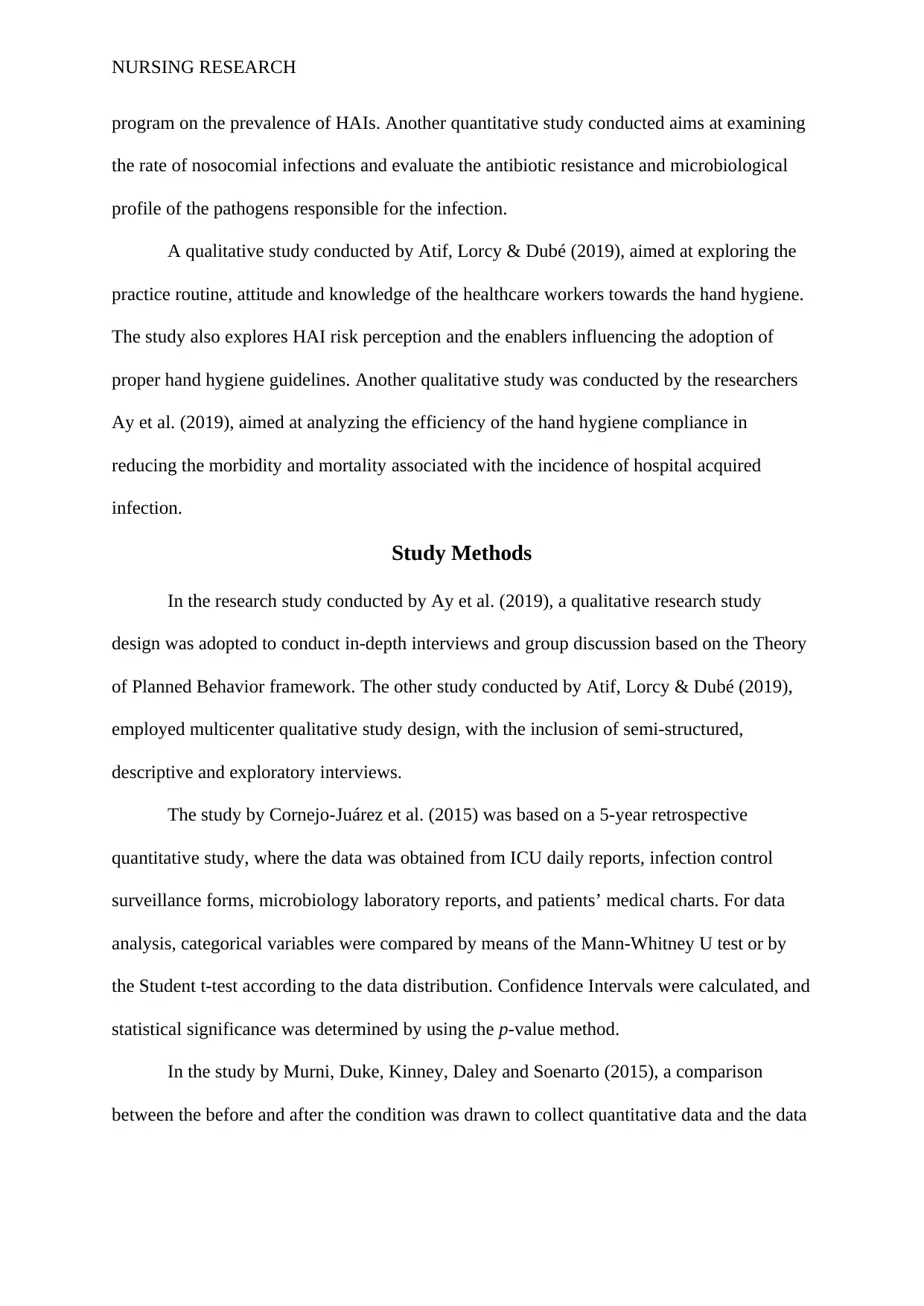
NURSING RESEARCH
program on the prevalence of HAIs. Another quantitative study conducted aims at examining
the rate of nosocomial infections and evaluate the antibiotic resistance and microbiological
profile of the pathogens responsible for the infection.
A qualitative study conducted by Atif, Lorcy & Dubé (2019), aimed at exploring the
practice routine, attitude and knowledge of the healthcare workers towards the hand hygiene.
The study also explores HAI risk perception and the enablers influencing the adoption of
proper hand hygiene guidelines. Another qualitative study was conducted by the researchers
Ay et al. (2019), aimed at analyzing the efficiency of the hand hygiene compliance in
reducing the morbidity and mortality associated with the incidence of hospital acquired
infection.
Study Methods
In the research study conducted by Ay et al. (2019), a qualitative research study
design was adopted to conduct in-depth interviews and group discussion based on the Theory
of Planned Behavior framework. The other study conducted by Atif, Lorcy & Dubé (2019),
employed multicenter qualitative study design, with the inclusion of semi-structured,
descriptive and exploratory interviews.
The study by Cornejo-Juárez et al. (2015) was based on a 5-year retrospective
quantitative study, where the data was obtained from ICU daily reports, infection control
surveillance forms, microbiology laboratory reports, and patients’ medical charts. For data
analysis, categorical variables were compared by means of the Mann-Whitney U test or by
the Student t-test according to the data distribution. Confidence Intervals were calculated, and
statistical significance was determined by using the p-value method.
In the study by Murni, Duke, Kinney, Daley and Soenarto (2015), a comparison
between the before and after the condition was drawn to collect quantitative data and the data
program on the prevalence of HAIs. Another quantitative study conducted aims at examining
the rate of nosocomial infections and evaluate the antibiotic resistance and microbiological
profile of the pathogens responsible for the infection.
A qualitative study conducted by Atif, Lorcy & Dubé (2019), aimed at exploring the
practice routine, attitude and knowledge of the healthcare workers towards the hand hygiene.
The study also explores HAI risk perception and the enablers influencing the adoption of
proper hand hygiene guidelines. Another qualitative study was conducted by the researchers
Ay et al. (2019), aimed at analyzing the efficiency of the hand hygiene compliance in
reducing the morbidity and mortality associated with the incidence of hospital acquired
infection.
Study Methods
In the research study conducted by Ay et al. (2019), a qualitative research study
design was adopted to conduct in-depth interviews and group discussion based on the Theory
of Planned Behavior framework. The other study conducted by Atif, Lorcy & Dubé (2019),
employed multicenter qualitative study design, with the inclusion of semi-structured,
descriptive and exploratory interviews.
The study by Cornejo-Juárez et al. (2015) was based on a 5-year retrospective
quantitative study, where the data was obtained from ICU daily reports, infection control
surveillance forms, microbiology laboratory reports, and patients’ medical charts. For data
analysis, categorical variables were compared by means of the Mann-Whitney U test or by
the Student t-test according to the data distribution. Confidence Intervals were calculated, and
statistical significance was determined by using the p-value method.
In the study by Murni, Duke, Kinney, Daley and Soenarto (2015), a comparison
between the before and after the condition was drawn to collect quantitative data and the data
Paraphrase This Document
Need a fresh take? Get an instant paraphrase of this document with our AI Paraphraser
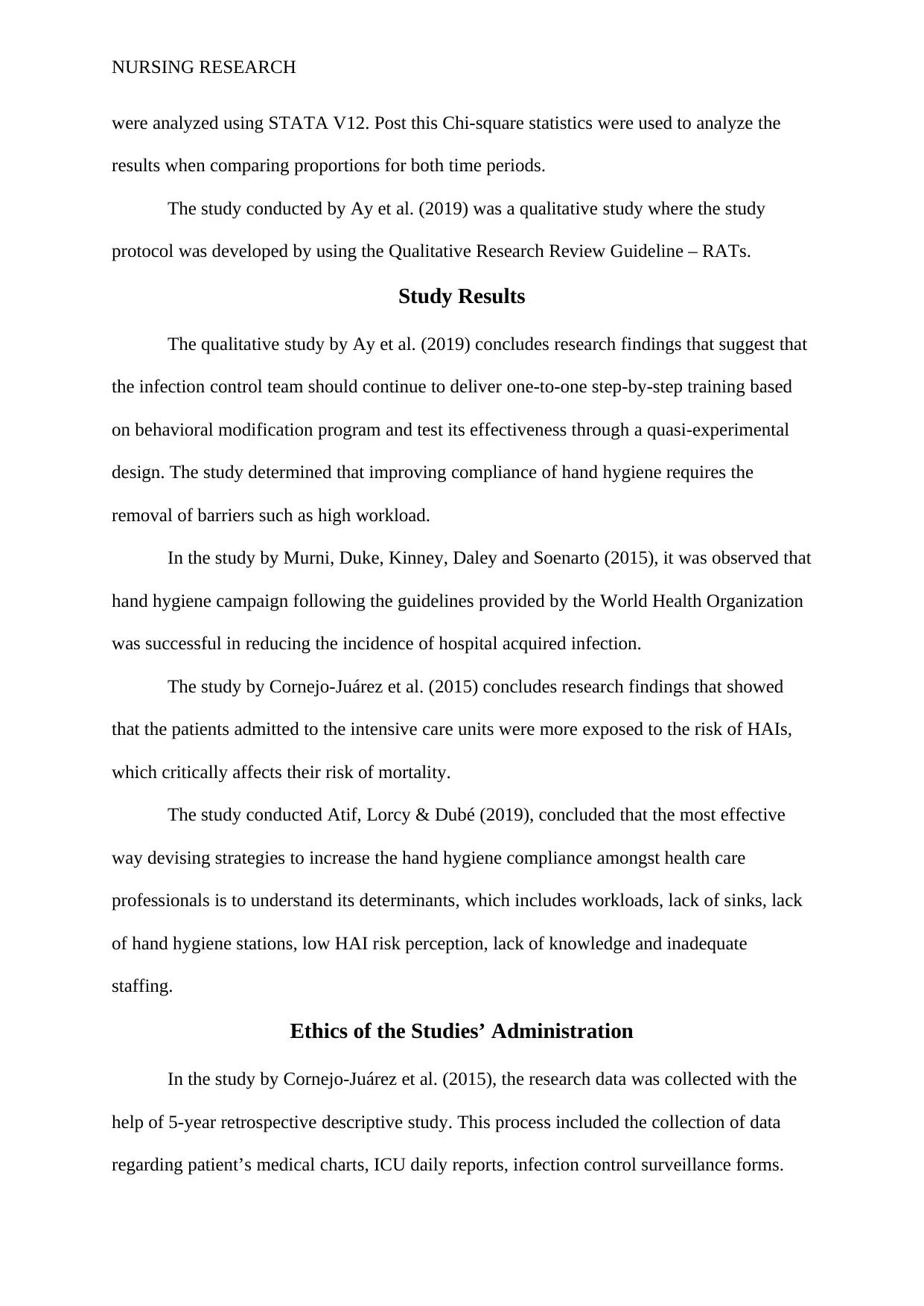
NURSING RESEARCH
were analyzed using STATA V12. Post this Chi-square statistics were used to analyze the
results when comparing proportions for both time periods.
The study conducted by Ay et al. (2019) was a qualitative study where the study
protocol was developed by using the Qualitative Research Review Guideline – RATs.
Study Results
The qualitative study by Ay et al. (2019) concludes research findings that suggest that
the infection control team should continue to deliver one-to-one step-by-step training based
on behavioral modification program and test its effectiveness through a quasi-experimental
design. The study determined that improving compliance of hand hygiene requires the
removal of barriers such as high workload.
In the study by Murni, Duke, Kinney, Daley and Soenarto (2015), it was observed that
hand hygiene campaign following the guidelines provided by the World Health Organization
was successful in reducing the incidence of hospital acquired infection.
The study by Cornejo-Juárez et al. (2015) concludes research findings that showed
that the patients admitted to the intensive care units were more exposed to the risk of HAIs,
which critically affects their risk of mortality.
The study conducted Atif, Lorcy & Dubé (2019), concluded that the most effective
way devising strategies to increase the hand hygiene compliance amongst health care
professionals is to understand its determinants, which includes workloads, lack of sinks, lack
of hand hygiene stations, low HAI risk perception, lack of knowledge and inadequate
staffing.
Ethics of the Studies’ Administration
In the study by Cornejo-Juárez et al. (2015), the research data was collected with the
help of 5-year retrospective descriptive study. This process included the collection of data
regarding patient’s medical charts, ICU daily reports, infection control surveillance forms.
were analyzed using STATA V12. Post this Chi-square statistics were used to analyze the
results when comparing proportions for both time periods.
The study conducted by Ay et al. (2019) was a qualitative study where the study
protocol was developed by using the Qualitative Research Review Guideline – RATs.
Study Results
The qualitative study by Ay et al. (2019) concludes research findings that suggest that
the infection control team should continue to deliver one-to-one step-by-step training based
on behavioral modification program and test its effectiveness through a quasi-experimental
design. The study determined that improving compliance of hand hygiene requires the
removal of barriers such as high workload.
In the study by Murni, Duke, Kinney, Daley and Soenarto (2015), it was observed that
hand hygiene campaign following the guidelines provided by the World Health Organization
was successful in reducing the incidence of hospital acquired infection.
The study by Cornejo-Juárez et al. (2015) concludes research findings that showed
that the patients admitted to the intensive care units were more exposed to the risk of HAIs,
which critically affects their risk of mortality.
The study conducted Atif, Lorcy & Dubé (2019), concluded that the most effective
way devising strategies to increase the hand hygiene compliance amongst health care
professionals is to understand its determinants, which includes workloads, lack of sinks, lack
of hand hygiene stations, low HAI risk perception, lack of knowledge and inadequate
staffing.
Ethics of the Studies’ Administration
In the study by Cornejo-Juárez et al. (2015), the research data was collected with the
help of 5-year retrospective descriptive study. This process included the collection of data
regarding patient’s medical charts, ICU daily reports, infection control surveillance forms.
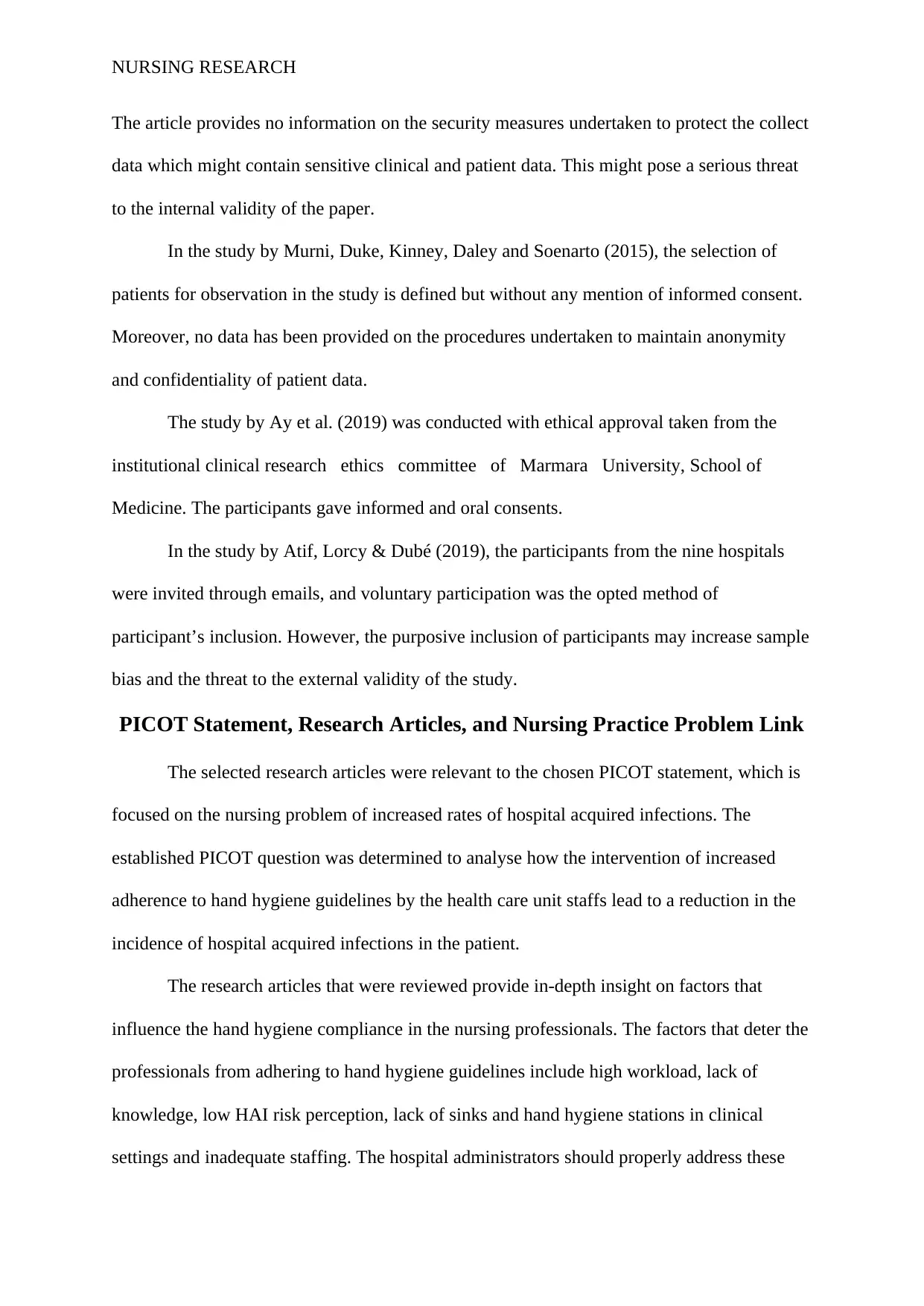
NURSING RESEARCH
The article provides no information on the security measures undertaken to protect the collect
data which might contain sensitive clinical and patient data. This might pose a serious threat
to the internal validity of the paper.
In the study by Murni, Duke, Kinney, Daley and Soenarto (2015), the selection of
patients for observation in the study is defined but without any mention of informed consent.
Moreover, no data has been provided on the procedures undertaken to maintain anonymity
and confidentiality of patient data.
The study by Ay et al. (2019) was conducted with ethical approval taken from the
institutional clinical research ethics committee of Marmara University, School of
Medicine. The participants gave informed and oral consents.
In the study by Atif, Lorcy & Dubé (2019), the participants from the nine hospitals
were invited through emails, and voluntary participation was the opted method of
participant’s inclusion. However, the purposive inclusion of participants may increase sample
bias and the threat to the external validity of the study.
PICOT Statement, Research Articles, and Nursing Practice Problem Link
The selected research articles were relevant to the chosen PICOT statement, which is
focused on the nursing problem of increased rates of hospital acquired infections. The
established PICOT question was determined to analyse how the intervention of increased
adherence to hand hygiene guidelines by the health care unit staffs lead to a reduction in the
incidence of hospital acquired infections in the patient.
The research articles that were reviewed provide in-depth insight on factors that
influence the hand hygiene compliance in the nursing professionals. The factors that deter the
professionals from adhering to hand hygiene guidelines include high workload, lack of
knowledge, low HAI risk perception, lack of sinks and hand hygiene stations in clinical
settings and inadequate staffing. The hospital administrators should properly address these
The article provides no information on the security measures undertaken to protect the collect
data which might contain sensitive clinical and patient data. This might pose a serious threat
to the internal validity of the paper.
In the study by Murni, Duke, Kinney, Daley and Soenarto (2015), the selection of
patients for observation in the study is defined but without any mention of informed consent.
Moreover, no data has been provided on the procedures undertaken to maintain anonymity
and confidentiality of patient data.
The study by Ay et al. (2019) was conducted with ethical approval taken from the
institutional clinical research ethics committee of Marmara University, School of
Medicine. The participants gave informed and oral consents.
In the study by Atif, Lorcy & Dubé (2019), the participants from the nine hospitals
were invited through emails, and voluntary participation was the opted method of
participant’s inclusion. However, the purposive inclusion of participants may increase sample
bias and the threat to the external validity of the study.
PICOT Statement, Research Articles, and Nursing Practice Problem Link
The selected research articles were relevant to the chosen PICOT statement, which is
focused on the nursing problem of increased rates of hospital acquired infections. The
established PICOT question was determined to analyse how the intervention of increased
adherence to hand hygiene guidelines by the health care unit staffs lead to a reduction in the
incidence of hospital acquired infections in the patient.
The research articles that were reviewed provide in-depth insight on factors that
influence the hand hygiene compliance in the nursing professionals. The factors that deter the
professionals from adhering to hand hygiene guidelines include high workload, lack of
knowledge, low HAI risk perception, lack of sinks and hand hygiene stations in clinical
settings and inadequate staffing. The hospital administrators should properly address these
⊘ This is a preview!⊘
Do you want full access?
Subscribe today to unlock all pages.

Trusted by 1+ million students worldwide
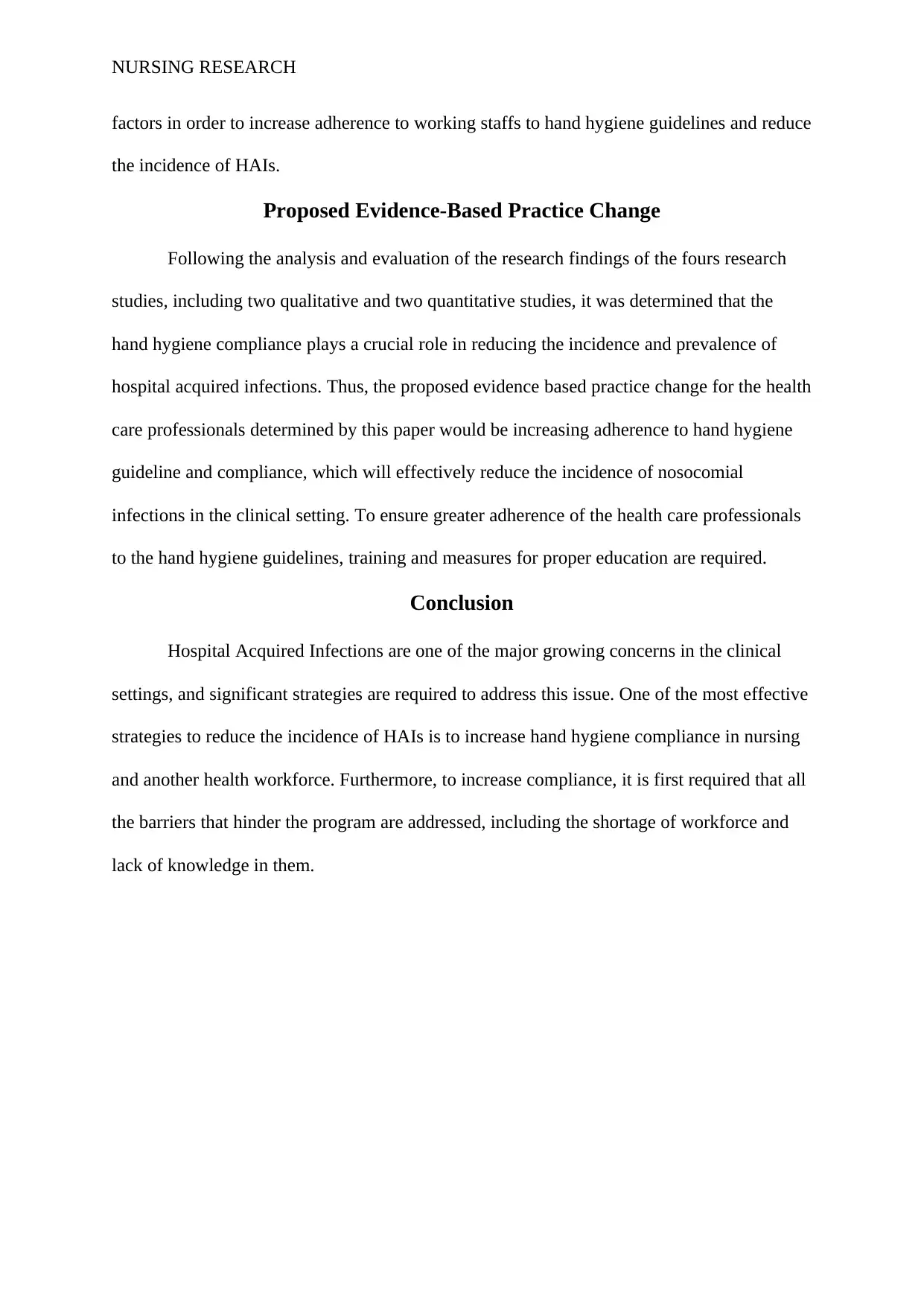
NURSING RESEARCH
factors in order to increase adherence to working staffs to hand hygiene guidelines and reduce
the incidence of HAIs.
Proposed Evidence-Based Practice Change
Following the analysis and evaluation of the research findings of the fours research
studies, including two qualitative and two quantitative studies, it was determined that the
hand hygiene compliance plays a crucial role in reducing the incidence and prevalence of
hospital acquired infections. Thus, the proposed evidence based practice change for the health
care professionals determined by this paper would be increasing adherence to hand hygiene
guideline and compliance, which will effectively reduce the incidence of nosocomial
infections in the clinical setting. To ensure greater adherence of the health care professionals
to the hand hygiene guidelines, training and measures for proper education are required.
Conclusion
Hospital Acquired Infections are one of the major growing concerns in the clinical
settings, and significant strategies are required to address this issue. One of the most effective
strategies to reduce the incidence of HAIs is to increase hand hygiene compliance in nursing
and another health workforce. Furthermore, to increase compliance, it is first required that all
the barriers that hinder the program are addressed, including the shortage of workforce and
lack of knowledge in them.
factors in order to increase adherence to working staffs to hand hygiene guidelines and reduce
the incidence of HAIs.
Proposed Evidence-Based Practice Change
Following the analysis and evaluation of the research findings of the fours research
studies, including two qualitative and two quantitative studies, it was determined that the
hand hygiene compliance plays a crucial role in reducing the incidence and prevalence of
hospital acquired infections. Thus, the proposed evidence based practice change for the health
care professionals determined by this paper would be increasing adherence to hand hygiene
guideline and compliance, which will effectively reduce the incidence of nosocomial
infections in the clinical setting. To ensure greater adherence of the health care professionals
to the hand hygiene guidelines, training and measures for proper education are required.
Conclusion
Hospital Acquired Infections are one of the major growing concerns in the clinical
settings, and significant strategies are required to address this issue. One of the most effective
strategies to reduce the incidence of HAIs is to increase hand hygiene compliance in nursing
and another health workforce. Furthermore, to increase compliance, it is first required that all
the barriers that hinder the program are addressed, including the shortage of workforce and
lack of knowledge in them.
Paraphrase This Document
Need a fresh take? Get an instant paraphrase of this document with our AI Paraphraser
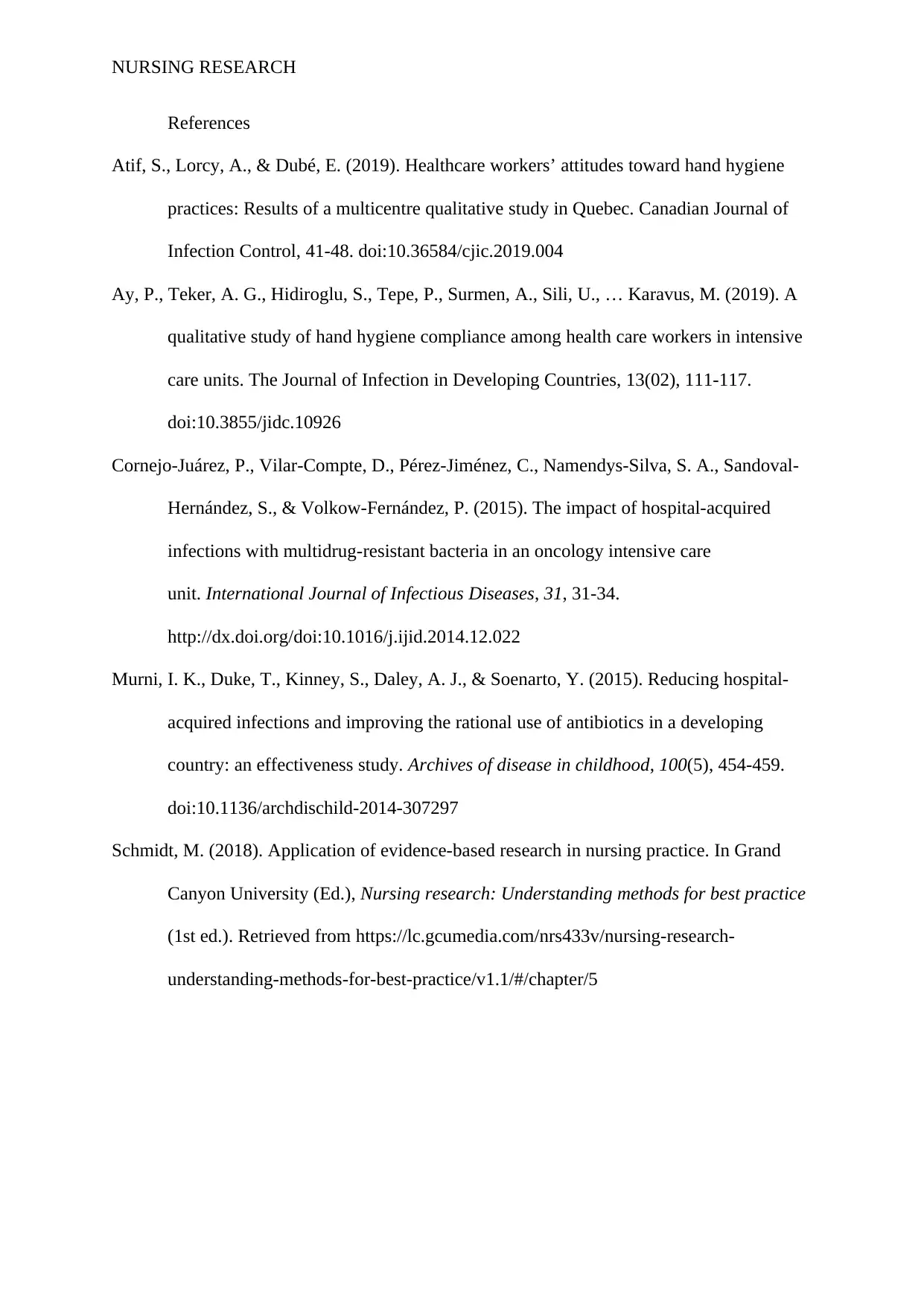
NURSING RESEARCH
References
Atif, S., Lorcy, A., & Dubé, E. (2019). Healthcare workers’ attitudes toward hand hygiene
practices: Results of a multicentre qualitative study in Quebec. Canadian Journal of
Infection Control, 41-48. doi:10.36584/cjic.2019.004
Ay, P., Teker, A. G., Hidiroglu, S., Tepe, P., Surmen, A., Sili, U., … Karavus, M. (2019). A
qualitative study of hand hygiene compliance among health care workers in intensive
care units. The Journal of Infection in Developing Countries, 13(02), 111-117.
doi:10.3855/jidc.10926
Cornejo-Juárez, P., Vilar-Compte, D., Pérez-Jiménez, C., Namendys-Silva, S. A., Sandoval-
Hernández, S., & Volkow-Fernández, P. (2015). The impact of hospital-acquired
infections with multidrug-resistant bacteria in an oncology intensive care
unit. International Journal of Infectious Diseases, 31, 31-34.
http://dx.doi.org/doi:10.1016/j.ijid.2014.12.022
Murni, I. K., Duke, T., Kinney, S., Daley, A. J., & Soenarto, Y. (2015). Reducing hospital-
acquired infections and improving the rational use of antibiotics in a developing
country: an effectiveness study. Archives of disease in childhood, 100(5), 454-459.
doi:10.1136/archdischild-2014-307297
Schmidt, M. (2018). Application of evidence-based research in nursing practice. In Grand
Canyon University (Ed.), Nursing research: Understanding methods for best practice
(1st ed.). Retrieved from https://lc.gcumedia.com/nrs433v/nursing-research-
understanding-methods-for-best-practice/v1.1/#/chapter/5
References
Atif, S., Lorcy, A., & Dubé, E. (2019). Healthcare workers’ attitudes toward hand hygiene
practices: Results of a multicentre qualitative study in Quebec. Canadian Journal of
Infection Control, 41-48. doi:10.36584/cjic.2019.004
Ay, P., Teker, A. G., Hidiroglu, S., Tepe, P., Surmen, A., Sili, U., … Karavus, M. (2019). A
qualitative study of hand hygiene compliance among health care workers in intensive
care units. The Journal of Infection in Developing Countries, 13(02), 111-117.
doi:10.3855/jidc.10926
Cornejo-Juárez, P., Vilar-Compte, D., Pérez-Jiménez, C., Namendys-Silva, S. A., Sandoval-
Hernández, S., & Volkow-Fernández, P. (2015). The impact of hospital-acquired
infections with multidrug-resistant bacteria in an oncology intensive care
unit. International Journal of Infectious Diseases, 31, 31-34.
http://dx.doi.org/doi:10.1016/j.ijid.2014.12.022
Murni, I. K., Duke, T., Kinney, S., Daley, A. J., & Soenarto, Y. (2015). Reducing hospital-
acquired infections and improving the rational use of antibiotics in a developing
country: an effectiveness study. Archives of disease in childhood, 100(5), 454-459.
doi:10.1136/archdischild-2014-307297
Schmidt, M. (2018). Application of evidence-based research in nursing practice. In Grand
Canyon University (Ed.), Nursing research: Understanding methods for best practice
(1st ed.). Retrieved from https://lc.gcumedia.com/nrs433v/nursing-research-
understanding-methods-for-best-practice/v1.1/#/chapter/5
1 out of 8
Related Documents
Your All-in-One AI-Powered Toolkit for Academic Success.
+13062052269
info@desklib.com
Available 24*7 on WhatsApp / Email
![[object Object]](/_next/static/media/star-bottom.7253800d.svg)
Unlock your academic potential
Copyright © 2020–2025 A2Z Services. All Rights Reserved. Developed and managed by ZUCOL.





